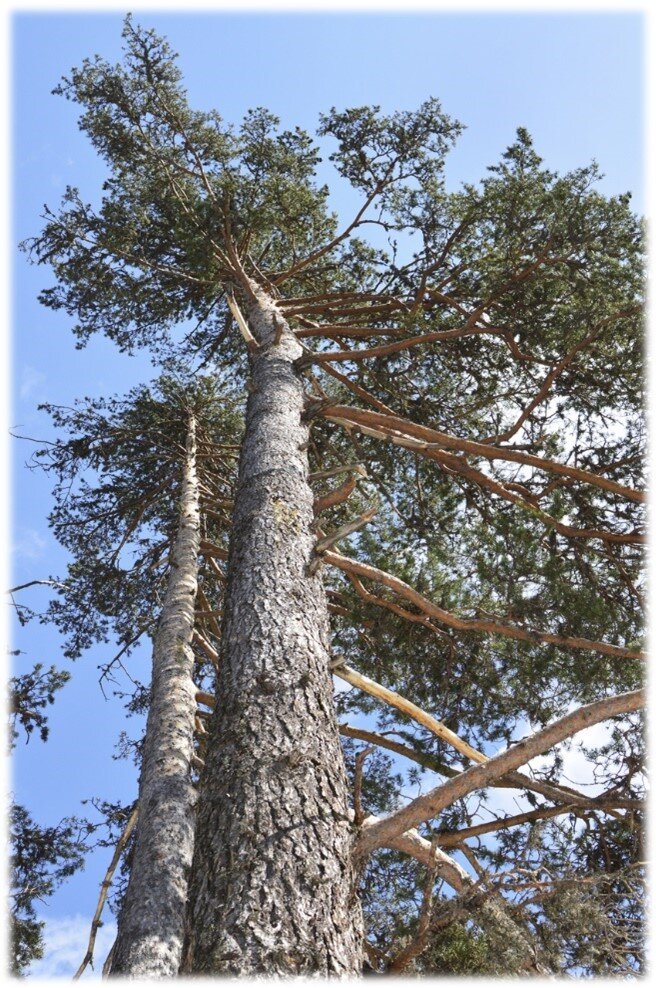Winter Foraging - the marvellous Scots Pine!
a new blog by Lauren Lochrie of Herbal Homestead
Scots Pine (Pinus sylvestris)
Identification
A needle-leaved evergreen, one of only three British native cone-bearing trees, alongside juniper and yew but is the UK’s only native pine species. ‘Scots’ pine in fact ranges across northern Europe, is a direct descendant of primeval forests which flourished long before broadleaves and is the only pine member to have survived the ice age.
With distinctive orange-brown, scaly bark (especially near the top), this wonderful tree can reach heights of over 30 metres (100 feet) and girths of 4.5 metres (15 feet) and can live for up to 700 years!
Scots pine form pairs of blue-green, needle-leaves and this distinguishes them from yew and spruce which have leaves set singly in spirals on the branch, and from larch which has leaves in groups.
Pines smaller leaf size therefore have a smaller surface area (compared to broadleaves) and a waxy outer coating which helps them withstand northerly frosts and windy conditions, so there is no need to shed all their leaves each autumn. Instead each needle pair persists for years and are shed throughout the seasons but not all at once. Such adaptations allow Scots pine to conserve and limit water loss helping them grow in sandy soils and drier conditions too.
Flowers
Scots pine is monoecious, meaning both male and female flowers grow on the same tree. Male flowers have clusters of yellow anthers at the base of shoots. Female flowers are small, red-purple and globular, and grow at the tips of new shoots.
Fruits
After pollination by wind, the female flowers turn green and develop into cones. They mature the following season, so there are always cones of different ages on the one tree. Mature cones are grey-brown with a raised, circular bump at the centre of each scale.
Three generations of cone can be found on a pine tree at any given time, sometimes all on a single branch, where new cones, fertilized and sealed cones, and empty cones stand one behind the other.
Traditional uses
Pine has an array of uses, more so traditionally were natives across northerly regions prized them as a timer for ships’ masts, pit props (in coal mines), and more recently for telephone poles and railway sleepers. Pine wood was also used to make ammunition boxes and for trenching in the First World War.
Other uses include using its tar and turpentine for making paints and varnishes, its volatile oils are used in cosmetics and perfumes. Pine resin went into glues used in boat building and for sealing wax and, when ground into powder, as rosin for violin bows. Pine pitch was the oil of pine, widely used as an antiseptic and a preservative: amber or fossilised pine resin preserves insects from as long ago as 125 million years.
Steam inhalations are popular for treating respiratory problems, using the bark or essential oil, along with drinking pine needle tea (see recipe below!). Herbalist Peter Conway recommends 10 drops of pine oil with 5ml of almond oil (as a carrier) poured into a hot bath as it fills; he says it is ‘wonderfully penetrating and relaxing, helping to release muscular tension’.
Ireland-based herbalist Nikki Darrell points out that pine is particularly valuable for treating asthmatics who have been on long-term steroids. Steroids have been connected with adrenal insufficiency, and pine acts as an adrenal restorative. Native Americans are among many pine-based cultures to find that pine sap will prevent wound putrefaction and help eliminate splinters and even bullets apparently!
Folklore and Scottish ‘Cloutie’ Wells!
The Clootie Well is a remnant of an ancient tradition once commonly found in Scotland and Ireland, of holy wells to which pilgrims would come and make offerings, usually in the hope of having an illness cured. The tradition dates far back into pre-Christian times, to the practice of leaving votive offerings to the local spirits or gods in wells and springs.
The holy well at Munlochy (Black Isle) is said to date back to - and probably beyond - the time of St Boniface or St Curitan, who worked as a missionary in Scotland in about AD620. Pilgrims would come, perform a ceremony that involved circling the well sunwise three times before splashing some of its water on the ground and making a prayer. They would then tie a piece of cloth or "cloot" that had been in contact with the ill person to a nearby tree. As the cloot rotted away, the illness would depart the sick person.
Wells like this can be found in a number of places in Scotland. One such example, The Fairy Tree, stands on the summit of Doon Hill outside Aberfoyle, where according to local legend, the Reverend Robert Kirk, who was abducted by fairies in 1692, left his spirit in this ancient pine tree.
Modern research & ‘biomimicry’
Pine contains a category of flavonols called oligomeric proanthocyanidins (OPCs). These serve to protect the body’s collagen against cell damage and thereby have a role in cancer prevention; moreover, OPCs have been shown to slow the accumulation of fat in the arteries and reduce risks of heart disease (Y. Liu et al 2013 & B. M. Fernandes et al 2014) - National Center for Biotechnology Information database.
Recent explorations into using natures genius to better design, man-made structures came from Z. Guo et al in 2019 where they replicated the structure of pine needles to design icephobic/anti‐icing surfaces and materials that can be extended into some applied realms for solving icing problems, e.g., transmission line, traffic road, aircraft wing, etc.
Recipes!
Pine Needle Tea
1. Use a small bunch of fresh pine needles per cup of boiling water in a teapot.
2. Cover the needles first with a bag and bash them with a rolling pin or something similar over a chopping board
3. Pop the needles in the teapot and steep for 10 minutes
4. Add honey or sugar to your taste
5. Strain and drink
Add some ‘spikey spruce’ tree needles too (they add a lovely fruitiness). This can also be used as a steam inhalation. You can use dried needles too, they have a more soothing, soapy feel.
Herbal Muscle Soak
The salt and herbs in this bath salt work together to relax tired muscles, improve circulation and ease aches and pains.
What you will need:
- 100g of salts of your choice (e.g. Epsom, dead sea, pink Himalayan)
- 2 teaspoons of chopped fresh or dried pine needles
- 2 teaspoons of chopped fresh or dried eucalyptus leaf
- 2 teaspoons of chopped fresh or dried lavender flower heads
- 2 teaspoons of dried daisy heads
- 10 drops of essential oil of your choice (e.g. pine, rosemary, lavender, mint etc)
Method:
1. Put the salts and herbs in a blender and pulverise them together (this allows better release of the medicinal properties)
2. Transfer the mixture to a glass or ceramic bowl, add the essential oils and mix
3. Add the mixture to a square of muslin or a clean sock and tie closed with string and tie below your hot water tap.
4. Let the water run through and dissolve the salts and the herbs to be retained inside (to prevent a drain blockage)
5. Add cold water to the bath as desired and soak and relax in it for at least 30 minutes.
*This mix can also be made in bulk (with dried herbs) and stored in a sealed jar in a cool, dark place for up to 1 year.
Herbal muscle soak with herbs and essential oils





